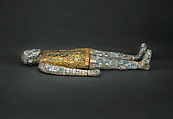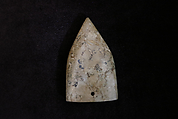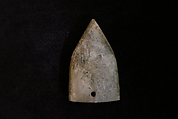Returned to lender The Met accepts temporary loans of art both for short-term exhibitions and for long-term display in its galleries.
Burial Ensemble of Dou Wan
Western Han dynasty (206 BCE–9 CE)
Not on view
This burial ensemble was excavated from the tomb of Dou Wan, wife of Prince Liu Sheng of Zhongshan. The suit consists of small jade plaques, each meticulously shaped and fitted together with gold wire to delineate the curves of the body. It represents the completion of a magical transformation of a deceased individual’s body, accomplished through a layering of jades. The first layer would have been the set of jade plugs seen here, which were inserted into the nine bodily orifices to seal the corpse. Next came a layer of small and large bi disks. The corpse was then encased in this suit, its head resting on the accompanying pillow. The ensemble of jades protected the body and the soul in their entirety, enabling the deceased to attain immortality.
#213. Burial Suit for Dou Wan
Due to rights restrictions, this image cannot be enlarged, viewed at full screen, or downloaded.
This artwork is meant to be viewed from right to left. Scroll left to view more.








